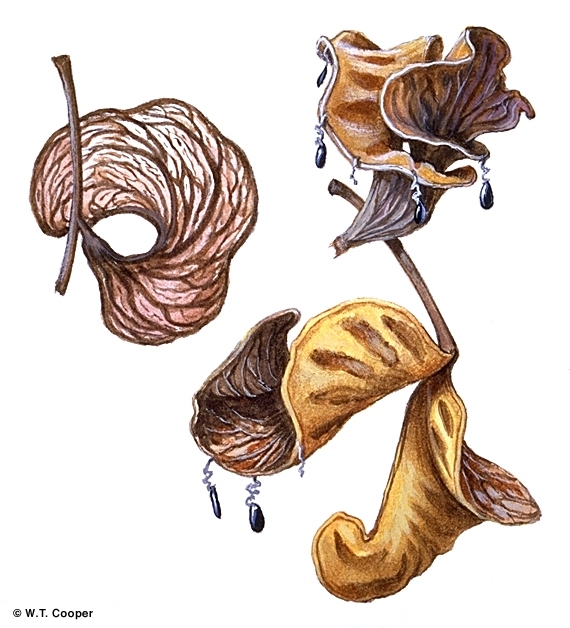Australian Tropical Rainforest Plants - Online edition
Acacia celsa Tindale





Tindale, M.D. (2000) Australian Systematic Botany 13: 34. Type: 2.5 km on Mission Beach Rd, 4 Oct. 1996, M. W. Mc Donald & P. A. Butcher; holo: NSW; iso: K, PERTH, BRI.
Wattle, Hickory; Salwood, Brown; Acacia Tree; Brown Salwood; Black Wattle; Brush Ironbark Wattle; Hickory Wattle; Wattle; Brown Salwood; Wattle, Brush Ironbark; Wattle, Black
Living bark strong and fibrous. Crown rather spreading but thin with the leaves on the periphery.
Leaves phyllodineous. Leaf blades about 6-10 x 0.9-1.9 cm, green or slightly glaucous, margins thickened like veins. Veins longitudinal, +/- parallel, not anastomosing, about 3-7 somewhat thicker than the rest. One marginal gland usually visible at the junction of the petiole and the blade.
Spikes yellow, moderately dense, about 2-5.5 cm long, on scurfy peduncles about 2-7 mm long. Calyx about 0.5-1 mm long with scurfy lobes, 0.2-0.3 mm long. Corolla about 1.5-1.9 mm long, glabrous, abut 2-3 times as long as the calyx, lobes about as long as the tube. Stamens about 3 mm long. Ovary shortly pubescent, scurfy.
Pod +/- flat, somewhat woody, prominently obliquely transversely veined, about 2-10 x 1-2 cm. Seeds shiny black, transversely oriented in the pod, about 5.5 x 2.5 mm. Funicle grey, white or cream, flat, rather broad, folded about five times forming an aril-like structure beneath the seed. Twisted curved pods usually present beneath mature trees.
Cotyledons oblong-elliptic, about 5-7 mm long. First leaf pinnate, second leaf bipinnate. At about the third or fourth leaf stage: leaves bipinnate, petiole broadly flattened. At the tenth leaf stage: leaves phyllodineous, linear or falcate, glabrous, usually with three main parallel veins running from the base to the apex; stem slightly 4-angled; stipules minute, falling early. Seed germination time 9 to 48 days.
Endemic to Queensland, occurs in NEQ and CEQ. Altitudinal range from sea level to 1100 m. Grows in well developed rain forest and some of the drier, more seasonal rain forests. This is a fast growing species which is favoured by disturbance and is a characteristic regrowth species in North Queensland rain forest. This species and the species complex formerly included in A. aulacocarpa is currently being revised and a number of new species will be described to accommodate the various entities previously included.
Although this is a fast-growing species it can produce reasonable logs and the timber can be quite useful. Sometimes used as a substitute for teak.
Wood specific gravity 0.80. Cause et al. (1989).





